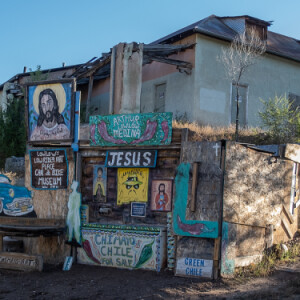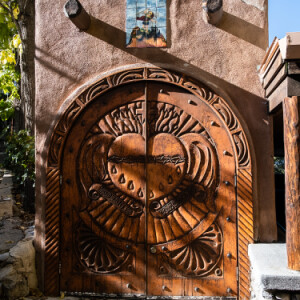The invaders' religion
The Poeh Cultural Center in Pojoacque (po-AH-kay) is an archive, a studio teaching traditional arts, and an exhibit area. The exhibits include recent artwork, pottery "returned" from various museums, and a six-room permanent exhibit, a diorama with sculptures (2-3 feet high) by Roxanne Swentzell (Santa Clara Pueblo) with painted murals by Marcellus Medina (Zia Pueblo). Their handout says the installation "portrays Pueblo history from within the Pueblo worldview." They conclude, "We live in the past and the present, simultaneously, in that we are who we are, have always been and we carry our past. We still need to remember our past as we go forward in this world of haste, distractions, individualism--a world of excessive sounds, video graphics, and other media imbedded in our homes now."
The exhibit shows the Pueblo people living in the rhythms of nature with a belief system that guides them. The brutal conquest of the Spanish and their priests is marked, leading to the Pueblo revolt of 1680, and the reconquest by the Spanish, followed by the US government.
When we entered and bought our tickets, the young man at the front desk said if we have questions, he'd try to answer them. After we had toured the exhibit, I told him we had seen the Native American Cenacle at the Santuario, and we wondered if there are difficulties in families because some believe Catholicism is the "invader's religion," and some have adopted that religion. He said it's complicated, that most families are willing to accommodate different beliefs, and that it is mostly generational--most young people reject Christianity, while some of their respected elders find it comforting.
After a half-day at the Poeh, we spent the rest of the day again at the Santuario, marveling at the difference a sunny day made (see Extras). Sunlight sets yellow Cottonwood trees and Aspens on fire like massive candles burning brightly against a deep blue sky.




Comments
Sign in or get an account to comment.


